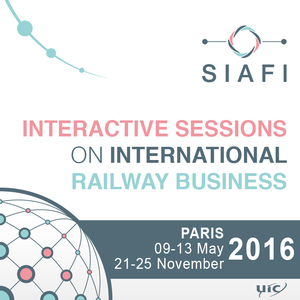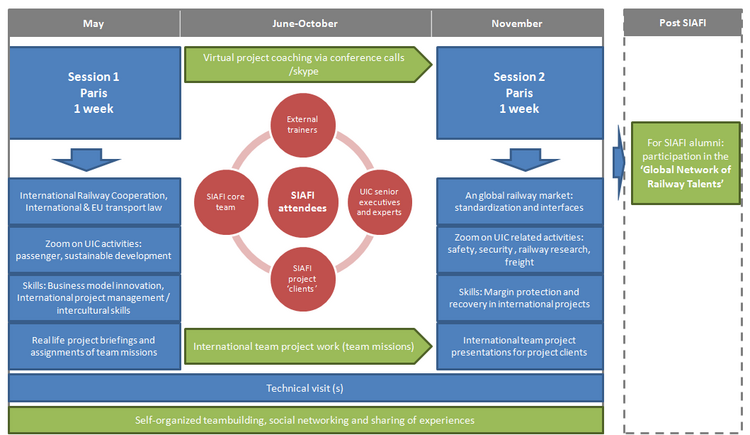One of the dimensions of the sustainable strategy is the social dimension. The Social Pillar, including training and education issues, is one of the three key pillars of sustainable development, along with environmental and economic issues. Training, education and workforce development have a key role to play to accompany and anticipate the transformations that are happening in many industries, including the rail sector.
Demands on railway organisations are changing: liberalisation, internationalisation/global market and supply chain, technical harmonisation and new technologies, as well as increasing service expectations, new social frameworks, demographic challenges and the loss of corporate knowledge.
It is of utmost importance for railway employers to attract and retain the best talents available in the job market.
To accompany these changes and support its members in their national approaches and efforts, the UIC General Assembly of December 2012 voted a global project “Network of railway talents” (TALENT project), which aims to create a strong and sustainable foundation for fostering international cooperation among the young and experienced talents in the railway sector.
One important aim of the project is also to facilitate the process of knowledge, values and experience sharing between different generations of railway people, as well as to stimulate the active dialogue between cultures and generations based on the principles of openness, respect and equality
The project is based on a set of complementary activities targeted at the development of junior and senior TALENTS.
Amongst the different training offers is the SIAFI training which has been for several decades the outstanding international railway training for managers from railway companies and other sector organisations. The increasing connectedness of railways make it more and more crucial
for companies to have international minded managers with a good understanding of the changing business environment, capable of sizing the challenges and opportunities for Railways. Both the important benchmarking opportunities within the railway industry offered by the programme and the active networking that fosters a truly global learning experience make us confident in the value that this programme can deliver to both participants and the sending organizations.
The participation in the SIAFI training is also a great opportunity to get your talents involved in the exciting and challenging TALENT project!
Jean Pierre Loubinoux
UIC Director General
Registration
An innovative action-learning programme
The SIAFInternational training programme is designed around a highly practical and collaborative learning approach. Built on the conviction that a professional training programme can only provide a strong positive impact for both the involved companies and organizations and the participating individuals if new learning can be applied in real situations, SIAFInternational contains a high level of individual and group-based active contribution.
Key benefits stemming from the proposed programme design:
Understanding the international railway cooperation environment
Over the last decades, attending the SIAFInternational has been a good opportunity to obtain a comprehensive overview of strategic issues for railways at an international level and also an ideal platform for promising young managers to discuss the “hot topics” of their area of work with colleagues from all over the world.
In this tradition, the SIAFInternational programme provides a broad introduction of the relevant railway stakeholders at international level and their respective roles in the international railway community as well as focused presentations of UIC activities covering the different aspects of the railway sector (operations, infrastructure, systems and technology, research, …).
Working on a set of crucial skills to drive collaborative innovation projects in the rail sector
With an increasing level of connectedness of the national railway networks and operations driven by the ongoing liberalization of the European rail markets as well as the ongoing efforts of the international railway community to support implementation and facilitate the operation of trans-continental rail corridors, a number of “transversal” competencies have become crucial to complete the skill sets of highly competent managers in the rail sector.
For this purpose , a large part of the programme is dedicated to more transversal features, such as:
- inter-session team coaching by external training professionals, consultants or academics.
- an international/intercultural project management approach;
- a structured yet highly creative tool for business model innovation;
- an introduction to Margin Protection & recovery in international industrial projects;
- a structured inter-session team coaching approach by external training professionals/consultants.
The revamped SIAFInternational training programme is designed to help individual participants to gain the skills and competencies necessary to succeed in a more and more complex and uncertain rail business environment.
Action-learning through live cases and the exchange of real world experiences
The SIAFInternational training programme encourages practical learning related to clearly identified innovation priorities expressed in real project challenges expressed by either a UIC Member organization, one of the UIC departments or an academic partner organization (project clients).
At the first session of the SIAFInternational, representatives of these project clients will present a specific project briefing and the projects will be assigned to a dedicated SIAFI project team who will work on the challenge in the period between the two SIAFInternational sessions.
During this inter-session project work period, the teams will be coached by an experienced external trainer/consultant with a background in the rail transport sector.
The results will be presented to the project clients at the second session of the SIAFInternational.
While the focus of the programme is clearly set on education and training of the participants, this highly practical project work aims at both providing a conduct for applying new learning and as a laboratory to work on team and personal leadership skills in a transversal and international setting.
The programme addresses the following areas:
- Sharing information about the profiles and strategies of the organizations of the programme participants, via the presentation and exhibition of posters produced by the participants;
- Introducing the international railway cooperation environment , identifying the principal stakeholders and understanding their different roles in the railway sector;
- Learning about the EU transport policy with a special focus on the developments in the international legal framework of the rail sector (international transport law, main EU directives and railway packages, …);
- Zooming into UIC activities in various fields: rail passenger transport, rail freight transport, sustainable development and energy issues, rail systems and technology, rail infrastructure business, safety management processes, security, rail research etc.;
- Transferring crucial transversal skills and competencies to better address the complexity of modern railways: international/intercultural project management, business model design and innovation, margin protection and recovery in international industrial projects, etc.
- Experiencing how to set-up an international collaboration project and thereby applying the lessons learned from the programme in a team-based real life project work, assisted and coached by the UIC training experts and external professional trainers/consultants;
- If these are some of the personal or organizational challenges you would like to address in your reflections about international railway management, then you should consider the SIAFInternational Programme as an important step in your career development.
SIAFI and the UIC Global Network of Railway Talents
Railway talents – Why bother?
For the transport and logistics sector, the talent crisis is no longer a problem of the future:
- Around the world, populations are ageing: developed countries will face a smaller percentage of active working population and in developing countries economic growth is already outpacing talent development, leading to serious skills shortage.
- Transportation and logistics companies, including rail, will have a harder time employing workers with the needed skills, in the right place, at the right time.
- Strategies for managing talent are now on top of the CEO agenda: in a recent survey by PwC, 66% of CEOs say that a lack of the right skills is their biggest talent challenge.
At a time of high unemployment in many parts of the world, this might seem as a contradiction, but in many sectors, including transportation and logistics and rail, there exist worrisome skills mismatches.
To address those challenges, the UIC aims to set-up a ‘Global Network of Railway Talents’. Through the provision of a common platform, the UIC wishes to extend the innovation capacity of the railway sector and to improve the sector competitiveness by fully using the potential of its talents.
Objectives, stakeholders and formats of the UIC Global Network of Railway Talents
Project objectives
- Development of a powerful management development programme to prepare a new generation of railway talents working on domestic and international challenges.
- Creation of a strong & sustainable foundation for fostering international cooperation amongst the young talents in the railway sector.
A global network of talents bringing together numerous stakeholders
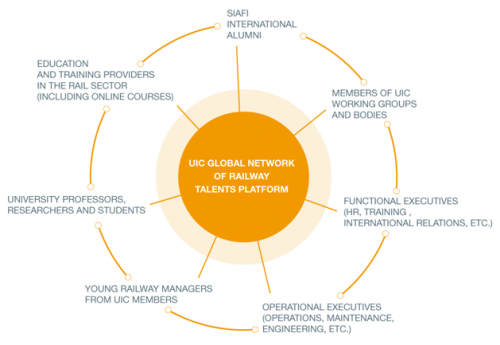
Forms of network engagement
- The network is supported by a powerful online platform which was implemented second half 2014.
- An annual collaborative network event is planned to provide opportunities for networking, learning and collaboration.
- The network engages relations with related UIC initiatives, in particular the UIC Research and Innovation Awards (through its “young researchers” category).
- The network is an information hub for international railway events such as conferences, workshops, training sessions, seminars, etc.
SIAFI Alumni at the heart of the new UIC Network of Railway Talents
- The UIC invites all current and former SIAFI participants (SIAFI Alumni network) to play a central role in the development of this new global network. Dynamic, open minded, multilingual and with strong technical and social skills, SIAFI alumni carry the right DNA to plant the seeds of a collaborative, engaging and open global network and to make it flourish over the coming years.
- Be part of it!
Is this a right programme for you?
Yes:
- if you are a talented railway professional with an appetite for international collaboration
- if you have recently made a career move to the railway sector after having had a first professional experience in another industry or sector
- if you are a university graduate with a specialization in engineering, transport economics, international cooperation/development or any other sector relevant background and if you are considering starting a career in the railway sector(?)
Ideal participants include:
- Railway managers working in railway business and fulfilling a role with an international job dimension: international public affairs, international relations, international corporate or institutional communications …
- Railway managers responsible for international cooperation projects or working in a context where a sound understanding and knowledge of international railway affaires is useful;
- Railway managers wishing to broaden their horizons and to enhance their awareness of the global dimension of the railway business;
- Railway managers involved in Research & Development or innovation focusing on the development of collaboration projects at an international level;
- High potential leadership candidates who might become part of, or who are interested in, fulfilling international job roles;
- Professionals who are involved in international, intercultural or multidisciplinary projects in the rail sector;
- Experienced rail policy or research staff within railway companies, international organizations, think tanks, universities and related agencies interested in learning more about the most recent economic, political and legal developments in the rail sector.
You should consider this programme if you want to better understand the international railway cooperation environment, acquire a set of crucial skills to drive collaborative innovation projects and get a flavour of what international cooperation is about and how it works.
Experience has shown that a mixed audience of participants with different backgrounds, different levels of experience bringing in multiple perspectives due to their multi-disciplinary backgrounds leads to the best learning experiences. Therefore, participants’ profiles can range from university graduates with a specific background in rail transport to mid-level managers (5-10 years of professional experience).
Participants should have a good command of English
Who teaches the SIAFInternational Programme?
The SIAFInternational Programme brings together a teaching team of recognized railway experts. They are leaders in their field engaged in enhancing the attractiveness and competitiveness of the rail sector.
The team consists of a mix of:
- Top executives, department heads and expertise practice leaders of the UIC;
- Top executives, policy and strategic advisors from various international organizations in the rail sector (UNECE, UNIFE, CER, ERA, CIT, EIM, World Bank …);
- Top executives, experienced professionals and experts from UIC Member organizations (railway companies, rail infrastructure managers);
- External consultants, Academics, team coaches and facilitators.
You are kindly asked to indicate, upon registration, the project on which you (or your company) would like you to work in the frame of SIAFInternational.
A contact name is indicated for each project, please feel free to contact him/her if you need further information, before making your choice.
Team projects
This list of projects is based on 2015 pre-selection and is indicative
Project Topic I: Can High Speed Rail be used for freight?
Rationale/background:
We have now seen that Low Density High Value goods (LDHV) are taking a rather steady market share, suggesting that it is indeed a potential market for rail. High Speed Rail (HSR) is also growing around the world with a steady pace. But can HSR be used for freight? How feasible is that? This situation presents us with the challenge to study the current operational patterns of HSR around the world, revisit the current service designs and as a result identify ways to new designs based on innovative value-added services for different type of freight and different classes of passengers.
HSR should take into consideration the customer requirements in terms of price, speed, delivery, flexibility, reliability, frequency and efficiency of service offered, as well as security, marketing and public engagement. How these are divined in terms of freight?
New designs should be based on business analytics that provide the relevant feedback from customer and competitor/collaborator. Robust business models capable of guaranteeing the economics of these new designs in the long-term are also needed.
The project aims to study the technical and operational characteristics of High Speed Rail (HSR) ad their potential to transport freight in the future. Case studies from all over the world will be collected and examined in detail. Similarities and differences between technology, operations, management, policy and practice will be investigated. Comparisons of “Conventional Rail” with “High Speed Rail” shall be undertaken to understand the changes of high speed rail services and their impact on the society. Issues related to noise and externalities could also be studied. Analytical studies could be employed to better understand the performance of existing HSR systems. Designs of new network service for HSR could also be introduced. Expected outcomes shall include Innovative technologies and logistics patterns to use HSR for freight.
What will be the future of rail facilities such as rail passenger station, freight yards, terminals and interchanges? The meaning of these needs to be reviewed, clarified and reinstated.
Scope & target:
The project should aim to answer the following questions:
- What are the current service designs for HSR?
- What are current operational weaknesses of the conventional rail systems in comparison to HSR?
- Who is the customer? Who is the competitor? Who is the collaborator? How HSR sees them?
- What are the needs for new rail services (for both freight and passengers) by 2020; with what level of productivity and how HSR can develop them?
- What are the measures and critical factures to secure on-time delivery when the service is provided by a newly designed system? What is the role of HSR?
Expected outputs/deliverables:
Resume of discussions within the project group. This could include:
- An overview of the current situation in terms of HSR system designs, their strengths and weaknesses; Examples from all over the world should be provided, presented and discussed;
- A study on customer, competitor and collaborator vs HSR;
- Understanding of the business model for HSR to be used for freight, inc. customer satisfaction, investment choices and business expansion;
- New designs for rail services per type of freight based on efficient production patterns, innovative cost-effective solutions and service integration over time;
- Comparisons of “Conventional Rail” with “High Speed Rail” should be conducted to also understand the credentials of HSR for freight and their impact on the society.

Contact(s):
Dr Marin Marinov
Rail Education Group Manager & Researcher
Programme Degree Director
E: marin.marinov@newcastle.ac.uk
Project Topic II: Intelligent Rail Infrastructure and Services IRIS
Rationale/background:
Due to significant growth in transport demand rail infrastructure faces specific challenges today. Taking into account the expected growth in transport demand and the ever-rising customer expectations in terms of quality of service there is a need to step-increase the productivity of the legacy infrastructure assets. This requires the latter to be managed in a more holistic and intelligent way, using lean operational practices and smart technologies that can eventually conduce, to bettering the reliability and responsiveness of customer service and whole economics of rail transportation. Transport systems are in a dynamic context and the climate changing is very important in terms of influencing the transport system. People needs now complex transport services and the technology is ready to help the experts in designing and providing new concepts and systems as Mobility as a Service is.
Specifically improvements will have to be introduced within four complementary work streams, as follows:
- Mobility as a Service (MaaS) – MaaS refers to a new paradigm and concept in personal transportation in which travelers use services for transportation, rather than using personal vehicles such as cars. This shift is based on various innovative new mobility service providers in a mix with traditional transport services (railway). MaaS is a new concept which is based on multimodal transport systems and ICT for transport (Intelligent Transport Systems). What is the role of railway in this new approach or paradigm? How can trains provide services as part of MaaS?
- Intelligent mobility management and monitoring: focus on the development of a next-generation of advanced intelligent and automated rail traffic management systems supporting an integrated approach to the optimisation of rail operations at network, route and individual train level. Business and operational requirements (viz. customer service, capacity, speed, timekeeping, energy, asset management) with real-time field and asset condition monitoring for delivering normal or near-normal services during all but the most exceptional circumstances. Real-time data collection and analytics from trains and infrastructure for purposes of goal-oriented predictive and adaptive control of the traffic and to minimise disturbances with a view to ensuring a minimum impact on services delivered.
- Intelligent asset management: the management of railway assets is a really challenge and the applications of electronics and IT could cooperate together to find the best solutions for assets management in the field of railway transport.
- Intelligent energy management: looks at innovative approaches for improving the efficiency of energy usage in rail infrastructure and operation within a whole-system perspective. Smart concepts in intelligent design and management of energy systems for rail applications to be pursued from a whole-of-life perspective - from concept to implementation through the rail infrastructure design, procurement, manufacturing, construction, operations and maintenance phases.
Scope & target:
The project should aim to answer the following questions:
- What are the ways for making a better integration of railway in MaaS?
- What are the means for efficient asset management systems?
- What are the characteristics of a next-generation of advanced intelligent and automated rail traffic management systems?
- What are the measures for efficient energy usage in rail infrastructure and operation within a whole-system perspective?
Expected outputs/Deliverables:
Resume of discussions within the project group. This could include:
- An overview of the current situation with MaaS, ICT and intelligent technologies for MaaS and best practices in implementing the new paradigm.
- A study on practices and smart technologies for intelligent rail infrastructure;
- Intelligent mobility management and monitoring solutions and the most important aspects for an integrated and durable design of these systems;
- Intelligent asset management – the state of the art and integration with ERP;
- Intelligent energy management – Key/Common Performance Indicators and examples from different domains;
- Design a concept for a rail system as part of MaaS.
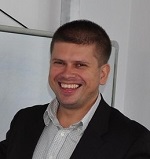
Contact(s):
Florin Codrut NEMTANU
Associate Professor, PhD, SM-IEEE, MIET "POLITEHNICA" University of Bucharest, Transport Faculty
E: florin.nemtanu@ieee.org
Project Topic III: Innovative intermodal transport services
Rationale/background:
At the European Union (EU) level, intermodal transport has received strong political support over the last two decades. Notwithstanding, at the EU level over 75% of freight (measured in tonne-kilometres) is still transported by road, intermodal transport accounts for only approximately 5% of total freight. The reasons for the difficulties facing intermodal transport are well documented in the literature. Firstly, there is the inherent complexity of producing intermodal transport services, since it involves streamlining five different types of flows – physical, logical, contractual, financial and relational – between multiple transport agents. Secondly, there are multiple external barriers, including: inadequate regulatory framework, absence of an intermodal liability regime and lack of integration between the transport networks. These complexities and the barriers contribute to hampering efficiency, raising production costs and reducing market opportunities for intermodal services. Thirdly, narrow policy options focused on the promotion of medium to long-distance intermodal transport.
Improving the intermodal transport market positioning requires an increase in competitiveness and the entry into new markets. In order to compete with road transport, rail and other companies must be able to deliver fully integrated transport chains, which necessarily entails the streamlining of the abovementioned flows. However, existent barriers hinder such ambition. Innovative solutions, exploiting new technological, operational and legal developments must be thought and deployed.
Scope & target:
Students are requested to propose solutions (existent or new ones) to promote the integration of intermodal rail services on a given international or intercontinental corridor?
The project should aim to answer the following questions:
- What are the distinguishing features of integrated rail-based services?
- What are the barriers preventing the integration of rail-based services (concerning the case study)?
- What solutions exist or must be developed to achieve the integration until 2020= What are the costs and respective benefits?
Expected outputs/deliverables:
- An overview of the fundamental variables and conditions to achieve integration.
- The identification of the barriers to integration, related with operations and network.
- Proposal of solutions to overcome the barriers on various dimensions:
- New technologies,
- New IT systems (e.g.: cloud based),
- New Monetary Systems (e.g.: bitcoins),
- New Contracts or Regulations,
- New Partnerships or Commercial Agreements.
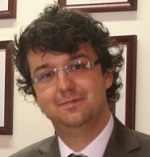
Contact(s):
Dr Vasco Reis
Instituto Superior Técnico, Universidade de Lisboa
E: vascoreis@tecnico.ulisboa.pt
Project Topic IV: New Business Models for Freight Transport Services
Rationale/background:
Significant investments have been channelled towards the railways transport systems at a worldwide level. Notably, at the European Union level, a substantial share of the Trans-European Network Transport is dedicated to railways. The primary objectives include the removal of the bottlenecks, the technological upgrade and an overall improvement of efficiency. Despite the efforts, the market exhibits slow reaction, with few new services and a struggling of the existing ones.
It is now time to go beyond the traditional infrastructure-oriented approach and start embracing a more market-oriented approach. In this context, the design of successful business models for the railway undertakings is of paramount relevancy to promote new services.
Taking into consideration that the current demand patterns often imply using rail services in the context of intermodal transport services, then it is also necessary to ensure that the railway undertaking’s business model fits into the intermodal transport service’s business model.
Scope and Target:
Students are requested to design successful business models solutions for both rail services and intermodal transport services.
The project should aim to answer the following questions:
- What are the potential market segments for railways services?
- What are the key components of a successful rail service business model?
- What are the key components of a successful intermodal service business model?
Expected outputs/deliverables:
- Characterisation of the demand for rail services.
- Understanding the principles and components of a business model.
- Designing new business models

Contact(s):
Dr Vasco Reis
Instituto Superior Técnico, Universidade de Lisboa
E: vascoreis@tecnico.ulisboa.pt
Project Topic V: Driver advisory systems and automatic train operation beside high speed rail (HSR) lines
Rationale/Background
High energy efficiency and thus a small carbon footprint are important features of the railway system. Flagship of passenger railway transport is usually the high speed rail operation (HSR) with modern technically equipped cabs and semi-automatic and automatic train operation (ATO). But a large proportion of traffic demand occurs beside the HSR lines in passenger and freight traffic. The locomotives and railcars used for this purpose are often several years and decades old and equipped according to technical standards in the past. So they don’t have systems for energy efficient driving like driver advisory systems (DAS) or ATO components on board.
Many railway undertakings (RU) operating beside HSR lines are forced to reduce costs in order to keep competitiveness. In addition to personnel costs, particularly energy / fuel costs are a large part of the expenses for the operation. To reduce these costs, trains have to be driven energy optimally as often as possible. However, this optimization cannot be done on the train only, but the overall traffic situation, passenger and cargo volume, special events and disturbances must be taken into account. Considering these aspects train drivers need technical support, e. g. DAS. Thus, ATO is the logical consequence for an always energy-optimal drive.
In this context, the question for RU is how to offer a good and competitive service (frequency, network connection, economic and ecological aspects). As part of this the energy saving potential that can be taped by DAS and ATO in non HSR area and economic and ecological effort that can be achieved are in the focus of the project.
Explore the role of UIC railway members’ organizations in relation to that field and develop an inventory of best practice cases.
Scope & target
Many important questions need to be addressed by RU. The project should aim several of them in reflection of the individual participants background:
- In which areas (freight -, regional passenger -, long-distance passenger transport) the use of DAS and ATO is useful. What energy saving potential can be tapped? How much reduction is necessary for economic reasons? What are the trends?
- Under what conditions is manual drive with advice preferable? When is automatic train operation preferable?
- What can be learned from the ATO in HSR, underground and light rail?
- What are the safety aspects? What are the legal aspects?
- What human factors must be considered in these systems in the cab?
- How are the systems connected to infrastructure manager to get an overall optimum?
- Are the systems interoperable? What have to be done to get interoperable systems?
Objective of this project team is to identify the major challenges railways face with regard to ATO and DAS for energy efficient driving beside HSR lines and to develop ideas and innovative concepts for the advisory systems of the future that address those challenges.
Expected outputs / deliverables
Resume of discussions within the project group. This could include:
- Overview on current situation of project team member’s organizations in terms of ATO and DAS for energy efficient driving, including review and analysis of research projects, pilot cases, prototypes and new concepts;
- Common understanding as shared vision of most important challenges railways are faced with in relation to ATO and DAS;
- Set of possible new ideas/initiatives/solutions how to address those challenges;
- Identification of a strategy railway companies need to implement DAS for energy efficient driving or ATO functions into their vehicles and operation;
- Development of measures for increasing energy efficient driving by using technical assistance to the train driver

Contact(s):
Dr. Martin Lehnert,
Technische Universität Dresden,
„Friedrich List“ Faculty of Transportation and Traffic Sciences
Research Associate
E: martin.lehnert@tu-dresden.de
Project Topic VI: Infrastructure Charges Fees – Track Access Charges
Rationale/background:
Railway sector is traditionally monopolist on transport market. Because of that fact European railway, suffer from losing the modal split, not only in passengers but also in freight transport. That way European Union suggest vertical separation of railway market so that exist possibility for new players on market. First step was accounting separation between infrastructure and transport; after that follow was, organize new company for infrastructure and for transport.
Nowadays, we know that exist Infrastructure managers (IM) and Railways Undertakings (RU). According to the legal standards direct way of communication between IM and RU is Infrastructure Charges Fees (Track Access Charges) respectively Network Statement. Infrastructure Manager issue at least two years in advice the Network Statement.
Very interesting thing that every Infrastructure Manager used they own system of model for charging infrastructure charges fees. So, for running the train in different country, for every country there is local model of charging and of course different so called service packages. Therefore, Railways Undertakings must have excellent knowledge of understanding and using the different charges and service systems of infrastructure charges fees.
Scope & target:
The project should aim to answer the following questions:
- What is Network Statement?
- Who is responsible for Network Statement?
- How to use Network Statement?
- How to calculate infrastructure train costs?
- How Infrastructure Managers treat (use, understand) Infrastructure Charges Fees?
- How Railways Undertakings treat (use, understand) Infrastructure Charges Fees?
- What the Regulatory Agency investigate on Infrastructure Charges Fees Schemes?
- What is the future of Infrastructure Charges Fees?
Expected outputs/deliverables:
- An overview of the current situation in Infrastructure Charges Fees.
- Practical knowledge to understand calculation of Infrastructure Charges Fees.
- Understand different between Passengers and Freight Infrastructure Charges Fees.
- Impact of Infrastructure Charges Fees in business of Infrastructure Managers and Railway Undertakings.
- Benchmarking of different services and fees across Europe.

Contact(s):
Asst.Prof. Borna Abramovic, Ph.D.
Head of Chair of Railway Transport Management
Department of Railway Transport
Faculty of Transport and Traffic Sciences
University of Zagreb
E-Mail: borna.abramovic@fpz.hr
A strong network of peers
A strong network is the basis for the development and facilitation of all forms of international cooperation. The SIAFInternational Programme brings its participants closer to a large network of rail professionals around the world who have experienced this international training for themselves.
Here are some examples of profiles of former SIAFInternational participants:
- Executive Marketing & International Organizations, DB German Railways
- Head of International Cooperation, Kazakhstan Temir Zholy Kazakhstan Railways
- Head of International Affairs, Zeljeznice Republike Srpske Republic of Srpska, Bosnia and Herzegovina
- Operations Expert, Italferr SpA Italy
- Deputy Head of Legal Affairs, Latvian Railways
- Business Development Director, Oltis Group
- Director of Legal and Organizational Department, PKP Polish Railways
- Expert International Cooperation, PKP Railways
- Specialist in the Economic Department, Przewozy Regionalne Ltd Poland
- Customer Service Manager, RENFE Spanish Railways
- Finance Controller Freight, RENFE Spanish Railways
- Sales and Network Manager, RFI Italian Railways
- Organizational Development Programme Manager, Translink Northern Ireland Railways
- Senior Advisor International Business, DB German Railways
- Senior Transport Operations Expert, Italferr SpA
- Senior Advisor International Affairs, Jernbaneverket Danish Railways
- Head of Human Resources and Administration, Latvian Railways
- Head of International Sales and Distribution, RENFE Spanish Railways
- International Project Manager, Bombardier Transportation
- Senior Legal Advisor, Jernbaneverket Danish Railways
- Signalling Engineer, Latvian Railways
- Head of Safety Management System, RFI Italian Railways
- European Standardization Manager, Siemens
- Head of R&D, SKF France
- Specialist International Relations, CD Czech Railways
- Marketing Advisor, Infrabel
- Business Development Manager, NS Netherlands Railways
- European Affairs Manager, NS Netherlands Railways
- International Business Manager, SNCF Freight
- Director Corporate Communications, VR Group Ltd
- Head of International Department, CD Cargo Czech Railways
- Head of Marketing, Litrail Lithuania
- Transport Policy Advisor, Banverket Swedish Railways
- Project Leader Training, FS Italian Railways
- Coordinator Interoperability, ÖBB Austrian Railways
- Deputy Director for restructuring, ZS Serbian Railways
- Head of section Strategy Department, MAV Hungarian Railways
- Pricing & Services Manager, SBB Swiss Railways
- Professional Performance Manager, Trenitalia Italian Railways
- Manager International Department, JR East, Japan Railways
- Project officer, European Railway Agency
- Director SkillSmart, Australia
- General manager strategic planning, DMRC Delhi metro rail corporation, India
Frame: A global network of railway talents
Talents – Why bother?
For the transport and logistics sector, the talent crisis is no longer a problem of the future
Transportation and logistics companies, including rail, will have a hard time employing workers with the needed skills, in the right place, at the right time. Therefore, strategies for managing talent are now on top of the CEO agenda. According to a recent CEO survey conducted by PwC, 66% of CEOs say that a lack of the right skills is their biggest talent challenge.
Companies in the transport sector are facing several major challenges:
1. The image problem
Many experts point out that the transportation industry is already having trouble attracting young and skilled people. The sector isn’t viewed as attractive by most job seekers – when it’s considered at all. Many transport jobs are considered to be low-paying dead-ends. Higher skilled roles with good pay and advancement potential don’t even make the radar screen of many talented graduates.
To tackle that challenge, transportation executives need to make improving the sector’s image a top priority and the commitment should come straight from the top.
2. A need for more and better training programmes to support learning and development
The economic globalization and reform of the rail transport systems within the UIC membership creates new requirements for workforce development to ensure that managers are equipped to deal with the challenges of a liberalized rail market and privatization.
More training and learning opportunities are therefore needed. As the rail sector is getting more interconnected and international, a stronger focus on intercultural and language skills is essential. National and international agencies will need to adapt educational offerings and vocational training systems in response and companies must make sure that apprenticeship and trainee programmes, for example, really prepare workers for future challenges.
3. Finding and winning the best talents
Improving recruiting efforts will be important all over the world. Railway companies are now seeking actively to recruit from the younger generations as the railway workforce is ageing and there is a need for new staff with fresh ideas and a good understanding of the environment within which railways operate.
However, the Millennial Generation (the generation which entered the workforce during the 21st century) has different aspirations and expectations from the organizations that they want to work for and companies need to better understand this new generation.
Attracting more women to the male-dominated rail sector is also a challenge. Finally, with older workers making up a greater part of the workforce, companies need to rely on them more. Adapting work environments to the needs of older workers and managing knowledge and skills transfer between generations will be important bricks in the people strategies of successful companies.
To tackle these challenges at an international level in the railway community, the UIC aims to set up a global network of railway talents
The UIC reckons that it has an important role to play by engaging an active dialogue across the rail sector, attracting talented railway staff to make a career in the railways. Therefore, the UIC General Assembly voted in December 2012 a new project led by the UIC Expertise Development Unit to address this issue.
At the core of the project is the development of a powerful international network of railway talents aiming to prepare a new generation of railway managers working on domestic and international challenges, with a deep understanding of business approaches, multi language skills, well known and recognized by the international railway community. With the establishment of this network, the UIC wishes to create a strong foundation for international cooperation amongst railway talents.
Together with the revitalization of the SIAFInternational (a sector-wide internationally recognized training programme for promising railway professionals with an appetite for international collaboration and global knowledge of the complexities of the railway system) and the implementation of two special award categories promoting both individual railway talents and international cooperation efforts at the UIC Innovation Awards 2014, the project addresses several of the above mentioned challenges in a collaborative way.
The details of the “UIC Network of Railway Talents” in terms of content, configuration, functionalities and associated events are currently being developed by the UIC Expertise Development Unit. However, the implementation of a web-based platform to facilitate the interactions between participants has already been identified as a key condition for the future success of the network and SIAFInternational alumni will clearly be in the heart of its development.
The TALENT on-line platform is operational since December 2014 (www.railtalent.org)
Testimonials
Testimonial n° 1
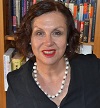
In 2014, I participated in the SIAFI program at the International Union of Railways (UIC), Paris. This was a fantastic experience to learn about the international environment of the rail industry with peers from companies across the world. In my role in Australia, I work as an independent consultant in the area of workforce development in the rail industry. This program provided me the opportunity to develop higher level skills and knowledge about the global rail industry while developing new networks with talented rail industry people from across the world.
The program was extremely well organised and comprised class-based learning sessions delivered over one week, in April, in Paris. During this time, participants provided background information about their role as well as an overview of their company. Facilitators of individual sessions provided in-depth knowledge about various aspects of the rail industry including the rail cooperation context, rail legalisation, standardisation and interfaces, rail passenger transport, business model innovation and the management of international projects. The session on intercultural issues provided an insight into the challenges of a global rail industry. As part of the learning experience, participants were exposed to the culture, life and food in Paris which enhanced both the first and second weeks of the program considerably!During the SIAFI program, I had the privilege of working on an action learning project with three other team members from Switzerland, Austria and Finland to design a solution to the challenge of increasing the capacity of rail freight. Our team used Skype to meet on a regular basis to discuss the SMART Freight Services project. In this process, we developed greater cultural understanding, a strong team bond and an international network for the future. The solution designed was innovative and our team had the opportunity to present this product to the UIC Freight Department.
The second week of the program involved topics on rail research, safety and security, sustainable development, a visit to the SNCF maintenance workshop, the future of rail freight and information on margin protection and recovery in international industrial projects.
I would highly recommend the SIAFI program to rail industry professionals who want to develop their knowledge and skills for the global context.
Dr. Janene Piip
Skillsmart, JP Research & Consulting
Testimonial n°2:

During the period between May 2012 and October 2012 I attended SIAFInternational.
During this training, which consisted of two weeks of classroom and teamwork throughout the months between May and October, I developed an interesting project together with other four participating colleagues from different countries.At the end of the training this experience brought me many benefits. First of all I acquired some important technical knowledge which has later been very useful for my job. For example, I could use the technical data about the maximum speed in Japan in the pre-feasibility study of High Speed lines in Algeria. I was the only expert on our team with this information, acquired directly by a Japanese colleague during SIAFInternational.
I also improved my management skills. SIAFI gave me the opportunity to coordinate a group of colleagues from different nationalities and backgrounds. As team coordinator, I gained experience that I could immediately apply after the training. My company Italferr gave me the opportunity to coordinate the Italian part of a team for a project in Algeria. The skills I acquired at SIAFI proved to be very useful, and I successfully coordinated a lot of colleagues specialised in different areas.Finally, I contributed to the creation of a European and international network with young railway colleagues, which is valuable for sharing information and fostering team work and collaboration
During SIAFI I worked on a team to develop a project named “Talent Wars”. This was the first time I had the opportunity to work on a social issue. This experience led me to encourage other colleagues to constantly stimulate and involve our younger colleagues. This was therefore a new work experience from a somehow different point of view.
This experience also enabled me to practise the English language, and it was an important test of my language capacity. I could benefit from this experience a few months later when I did a technical course in Serbia for young Italferr employees.
In my opinion taking part in this kind of training enables people to give their best, like being in a kind of competition. Moreover, it is a way to encourage and train young talents and it is an effective way to spread the core values of railway.Silvia NARDONI
Railway operation specialist / Middle supervisor
Testimonial n°3:
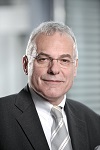
The railway business is becoming increasingly globalised. This means that railway managers as well as specialist railway staff must be familiar with the newest trends and "hot topics" of the globalised railway business. Or putting it in more practical terms: they must learn how to include the international dimension of their business in their professional decisions and actions. UIC’s SIAFInternational programme is an excellent learning and networking programme designed precisely to meet this objective.
I recently had the chance to participate in the programme. My task is to coordinate DB Training’s international projects. The SIAFInternational programme has provided me with the perfect knowledge and know-how for my job. SIAFInternational is a must for younger (and experienced!) railway managers and specialist staff: preparing them properly for these international railway contexts in which they will play an increasingly bigger role! Internalisation matters! And SIAFInternational as well!
Dr. Bernd Kiessling
DB Mobility Logistics AG
DB Training, Learning & Solutions
International Business
Testimonial n°4:

1. Why did you choose to participate in the SIAFInternational programme?
With SIAFI, UIC offers a wide range of up-to-date subjects relevant to railways, as well as opportunities for discussions with international colleagues and industry experts. The programme offers an overview of global questions, challenges and solutions and is a perfect supplement to national training programmes.2. What did you think of the programme?
SIAFI brings together managers and experts from railway companies from all around the world for a deep exchange of information, experience and knowledge. In the course of the programme, the big issues and latest technological, economic, legal and political developments are addressed, discussed and debated.3. What did you learn?
SIAFI brings a good understanding of integrated approaches to issues of organization, strategy, technology, operations management, financing, amongst other things, and enables these approaches, experiences and acquired knowledge to be incorporated into the daily work. In this way, the programme contributes to achieving pan-European targets, as the development of a harmonized and integrated European railway sector will be a key factor for the future success of railways.4. How have you been able to use the things you have learnt in your organization and job at Austrian Railways?
The rapid technological but also economic and legal developments raise new challenges to railways. We need to look beyond national borders and incorporate international knowledge into our daily work in order to deal with those new challenges. SIAFI offers a well-founded insight into the latest developments, potential solutions and best practice in companies from different countries and thereby helps to address complex issues in your own organization.5. What about the return on investment? For you and for your employer?
New technologies, changing political or legal conditions and increased competition demand new ideas in order to develop sustainable solutions. Sound training programmes at international level provide an excellent basis for this and also contribute to the competitiveness of the companies involved in those programmes. Training at international level could not be more cost-efficient.6. To whom would you recommend participation in the SIAFInternational programme?
SIAFI is available to all experts across the railway sector and its core tasks include strategic, technological, economic, legal and political but also intercultural issues.7. When you think about your SIAFI participation, how do you think the programme has to evolve and adapt to meet the current needs of the railway sector?
A fundamental factor for the training, which is already very well positioned, will be for the different railway companies to place even more emphasis on this programme in the career models and/or personnel development of future experts. In this way, it can be ensured that the acquired knowledge will be used in strategic managerial positions within a company.Franz Lehr
ÖBB Infrastruktur AG, Integriertes Streckenmanagement (integrated infrastructure management)
Testimonial n°5:

SIAFI provided me with the best opportunities for developing both expertise and networking. To me, SIAFI is quite like a mini-sized MBA program including both management courses and professional lectures, from which I learnt about business model innovation, project management as well as professional knowledge about world railway market, European railway policy, sustainable development, passenger and freight transport, research, railway systems, etc.
Most importantly, SIAFI is a place where you meet with friends from all over the world. With all the interaction during the program, not limited to the two-week workshop together, but also several months working together for the project, we learn from each other. We discover the culture of each other. We understand each other. We become friends. This is not only about business, not only about railway, but also, in a broader view, about the future of the world.
“How happy we are, to meet friends from afar!” as the great Chinese philosopher Confucius said. The world is big. But SIAFI is the right place to meet friends from afar and SIAFI makes the world smaller.
ZHAO Zhangshan
CARS (China Academy of Railway Sciences)
Student of SIAFI 2015
